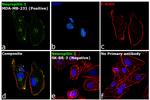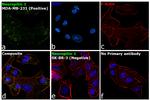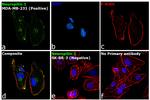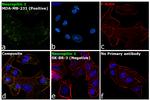Invitrogen
CD304 (Neuropilin-1) Monoclonal Antibody (XML1Y1), eBioscience™
This Antibody was verified by Relative expression to ensure that the antibody binds to the antigen stated.
FIGURE: 1 / 5
CD304 (Neuropilin-1) Antibody (14-3042-82) in ICC/IF





Product Details
14-3042-82
Species Reactivity
Host/Isotype
Class
Type
Clone
Conjugate
Form
Concentration
Purification
Storage buffer
Contains
Storage conditions
Shipping conditions
RRID
Product Specific Information
Description: The monoclonal antibody XML1Y1 recognizes CD304 (Neuropilin-1), a type 1 transmembrane glycoprotein present on the surface of multiple cell types, including: regulatory T cells (Tregs), NKT cells, DC, certain types of stem cells, neurons, endothelial cells, and some neoplastic cells. Neuropilin-1, in complex with plexins, serves as a co-receptor for type 3 semaphorins in growing neurons. It is also involved in the process of angiogenesis being a part of a functional receptor for VEGF in endothelial cells. In mouse Neuropilin-1 is expressed on thymus-derived natural Tregs but not peripherally induced Treg cells. In addition, transient expression on recently activated non-regulatory T cells has been observed. Neuropilin-1 has been used as a marker of recent thymic emigrants in the mouse iNKT cell population. It has been shown that Neuropilin-1 forms a complex with TGF beta receptors, activating TGF beta latent form (LAP-TGF beta 1) and augmenting canonic Smad2/3 signaling.
This XML1Y1 antibody recognizes neuropilin-1 isoforms 1 and 2.
Applications Reported: This XML1Y1 antibody has been reported for use in immunohistochemical staining of frozen tissue sections, and immunocytochemistry.
Applications Tested: This XML1Y1 antibody has been tested by immunohistochemistry of acetone-fixed frozen tissue sections and can be used at less than or equal to 1 µg/mL. This XML1Y1 antibody has been tested by immunocytochemistry of methanol-fixed bEND3 cells and can be used at less than or equal to 1 µg/mL. It is recommended that the antibody be carefully titrated for optimal performance in the assay of interest.
Purity: Greater than 90%, as determined by SDS-PAGE.
Aggregation: Less than 10%, as determined by HPLC.
Filtration: 0.2 µm post-manufacturing filtered.
Target Information
Neuropilin 1 is a 923 amino acid containing membrane bound coreceptor to a tyrosine kinase receptor belonging to the neuropilin family with two CUB domains, two F5/8 type C domains and a MAM domain. Neuropilin 1 forms a heterodimer with NRP2 (Neuropilin 2) and is known to bind to plexin (PLXNB1) to form semaphorin receptors. Expressed mostly in the nervous system this receptor is implicated in a wide range of functions including in the development of the cardiovascular system, angiogenesis, repulsive axon guidance, formation of certain neuronal circuits, cell survival, control of neuronal migration and organogenesis outside the nervous system. This semaphorin receptor functions as receptors for both the semaphorins and vascular endothelial growth factor and is also a regulator of VEGF-induced angiogenesis. Neuropilin 1 may be involved in aggressive advanced prostate carcinoma and in the progression of breast cancer.
For Research Use Only. Not for use in diagnostic procedures. Not for resale without express authorization.
References (0)
Bioinformatics
Protein Aliases: A5 protein; CD304; Neuropilin; Neuropilin-1; Neuropilin-1 precursor (A5 protein); Neuropilin1; NRP 1; sNRP 1; sNRP1; soluble NRP 1; soluble NRP1; transmembrane receptor; Vascular endothelial cell growth factor 165 receptor
Gene Aliases: BDCA4; C530029I03; CD304; NP-1; NP1; NPN-1; Npn1; NRP; NRP1; VEGF165R
UniProt ID: (Human) O14786, (Mouse) P97333
Entrez Gene ID: (Human) 8829, (Mouse) 18186

Performance Guarantee
If an Invitrogen™ antibody doesn't perform as described on our website or datasheet,we'll replace the product at no cost to you, or provide you with a credit for a future purchase.*
Learn more
We're here to help
Get expert recommendations for common problems or connect directly with an on staff expert for technical assistance related to applications, equipment and general product use.
Contact tech support
